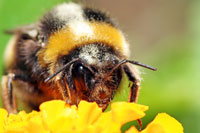 Next to the fruit fly, the most popular insect (arthropod) of the creation scientist could very well be the common honey bee. Much has been written and filmed of this insect's incredible ability to make perfectly-formed combs containing hexagonal cells for maximum utilization of space and heat transfer. The bee's ability to convey the location of a food source to fellow workers via a sophisticated "dance" is legendary.
Next to the fruit fly, the most popular insect (arthropod) of the creation scientist could very well be the common honey bee. Much has been written and filmed of this insect's incredible ability to make perfectly-formed combs containing hexagonal cells for maximum utilization of space and heat transfer. The bee's ability to convey the location of a food source to fellow workers via a sophisticated "dance" is legendary.
Twenty-first century research has now revealed that bee vision is more complex than anyone thought. According to science, arthropods have always been complex—and they have always been arthropods. One of the first arthropods found in the fossil record is the amazing trilobite, common in Cambrian and Ordovician sediments. Many of these creatures are so well preserved that a detailed analysis of their eyes has been possible:
The elegant physical design of trilobite eyes employ Fermat's principle, Abbe's sine law, Snell's laws of refraction, and compensates for the optics of birefringent crystals. Thus, trilobites could see an undistorted image under water. Imagine being able to see with undistorted vision in all directions, being able to determine distance in part of that range, while, at the same time, having the optimum sensor for motion detection.1
So, from the beginning, arthropod vision has been extremely complicated, a fact not clarified by Darwinism. Indeed, even explaining how the arthropod head supposedly evolved is an "acrimonious field."2
The composition of the arthropod head is one of the bitterest and longest-running problems in animal evolution. Unresolved after more than a century of debate, this sorry tale is (in)famously known as the "endless dispute."3
The arthropod head never evolved in the first place—it was created.
The brain of the bee is composed of a mere one million neurons (nerve cells), 0.01% of the neurons of a three-pound human brain. Using this tiny bee brain and associated vision, bees have been able to solve complicated color puzzles4 and even recognize human faces.5 They do this by using their 6,300 ommatidia that comprise the eye. Bees have also been created with the ability to distinguish up to 300 separate flashes of light per second, an attribute they use as they rapidly fly over the changing landscape.
The next time a busy bee buzzes by you on its way to a field, remember that it is designed to do and find things that our most sophisticated machines and computers cannot do, using vision and a brain that flies in the face (so to speak) of undirected evolution.
- Austin, S., Grand Canyon: Monument to Catastrophe, ICR, 1994, p. 145.
- Budd, Graham E., Telford, Maximilian J., "Evolution: Along came a sea spider," Nature, vol. 437, Oct. 20, 2005, p.1099.
- Ibid.
- Astrobiology Magazine, Nov. 6, 2005. http://www.astrobio.net/news/.
- Unger, K., ScienceNOW Daily News, Dec. 2, 2005, citing Journal of Experimental Biology.








